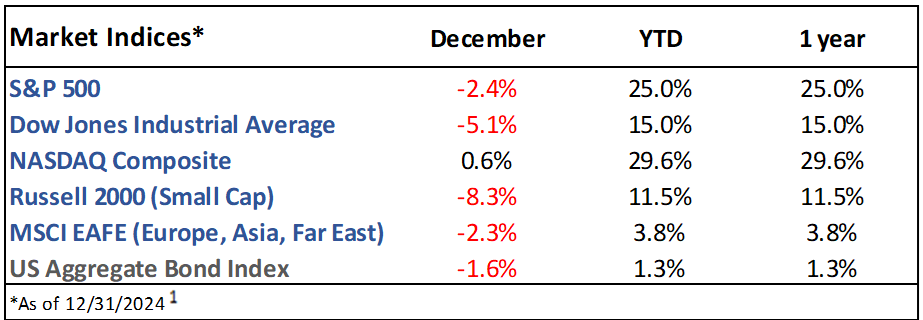December Market Update
Market Indices Performance

December Recap
The S&P 500 fell -2.4% in December to end 2024 with a 25% gain. The Nasdaq outperformed again to end the year with a 29.6% gain, while the Dow Jones rose 15%. International stocks fell sharply in December to end the year barely positive.(1) Bond yields rose dramatically as investors anticipate elevated growth and inflation in the coming years. The Federal Reserve cut interest rates by another 0.25% to a level of 4.25-4.50%. Inflation, measured by the Consumer Price Index (CPI), rose 2.9% from last year, marking the 46th straight month above the Federal Reserve’s 2% target (Figure 1).(2) The economy added 256k jobs, higher than the 164k expected. The unemployment rate fell slightly to 4.1% and has been in the 4.0%-4.3% range for eight straight months.(3) Job openings rose to 8.1m, and the ratio of jobs available to unemployed people remains healthily above 1.(4)

The Present
Q4 earnings season is now underway, with expectations for 11.7% growth.(5) Bond yields have been rising consistently as investors anticipate higher growth and inflation and a higher dollar under the Trump administration. The 10yr Treasury has risen from 3.6% in September to 4.6% today; the 2yr Treasury has risen from 3.6% to 4.2%. This rise has come despite three rate cuts totaling 1% in that time frame (see Figure 2).(6) Mortgage rates have risen to 7% after almost dropping below 6% in September.(7)

The Future
Analysts predict earnings growth of 15% for 2025.(5) As for interest rates, the Fed is predicting two for 2025 while the market expects only one.(8,9) January has historically been a good month for the stock market.(10) With the upcoming inauguration of President-elect Trump, there are several potential changes coming that will affect the economy and potentially the markets. He is planning to usher in increased tariffs (likely triggering at least a short-term rise in prices), lower taxes (by extending the Tax Cuts and Jobs Act and introducing additional tax eliminations), less immigration (likely reducing the labor force), less regulation (likely spurring economic growth), and more domestic oil production (likely easing inflationary pressures across the board).(11) Plenty of uncertainty remains around these policies and how they will affect the economy, but we and most of Wall Street are cautiously bullish overall on the Trump presidency.
1. https://ycharts.com/indices/%5ESPXTR, https://ycharts.com/indices/%5EDJITR, https://ycharts.com/indices/%5ENACTR, https://ycharts.com/indices/%5ERUTTR, https://ycharts.com/indices/%5EMSEAFETR, https://ycharts.com/indices/%5EBBUSATR – Index Performance
2. https://www.investing.com/economic-calendar/cpi-733 - CPI
3. https://www.investing.com/economic-calendar/nonfarm-payrolls-227 - Jobs reports
4. https://fred.stlouisfed.org/graph/?g=12kNG - Job openings
5. https://advantage.factset.com/hubfs/Website/Resources%20Section/Research%20Desk/Earnings%20Insight/EarningsInsight_011025A.pdf - Earnings expectations
6. https://www.cnbc.com/bonds/ - Treasury yields
7. https://fred.stlouisfed.org/series/MORTGAGE30US - Mortgage Rates
8. https://www.cmegroup.com/markets/interest-rates/cme-fedwatch-tool.html – Investor rate expectations
9. https://finance.yahoo.com/news/fed-cuts-rates-by-quarter-point-scales-back-cuts-for-2025-125715874.html- Fed Outlook
10. https://www.nasdaq.com/articles/heres-the-average-stock-market-return-in-every-month-of-the-year – Monthly market history
11. https://taxfoundation.org/research/all/federal/donald-trump-tax-plan-2024/ - Trump presidency likely outcomes
The Gasaway Team
7110 Stadium Drive
Kalamazoo, MI 49009
(269) 324-0080
FAX (269) 324-3834
The views expressed are those of the author as of the date noted, are subject to change based on market and other various conditions. This presentation is not an offer or a solicitation to buy or sell securities. The material discussed is meant to provide general education information only and it is not to be construed as specific investment, tax or legal advice and does not give investment recommendations.
Certain risks exist with any type of investment and should be considered carefully before making any investment decisions. Keep in mind that current and historical facts may not be indicative of future results.
Additional information, including management fees and expenses, is provided on our Form ADV Part 2 available upon request or at the SEC’s Investment Adviser Public Disclosure website, https://adviserinfo.sec.gov/firm/summary/123807.
This material was created for educational and informational purposes only and is not intended as ERISA, tax, legal, or investment advice. If you are seeking investment advice specific to your needs, such advice services must be obtained on your own separate from this educational material. ©401(k) Marketing, LLC. All rights reserved. Proprietary and confidential. Do not copy or distribute outside original intent.










